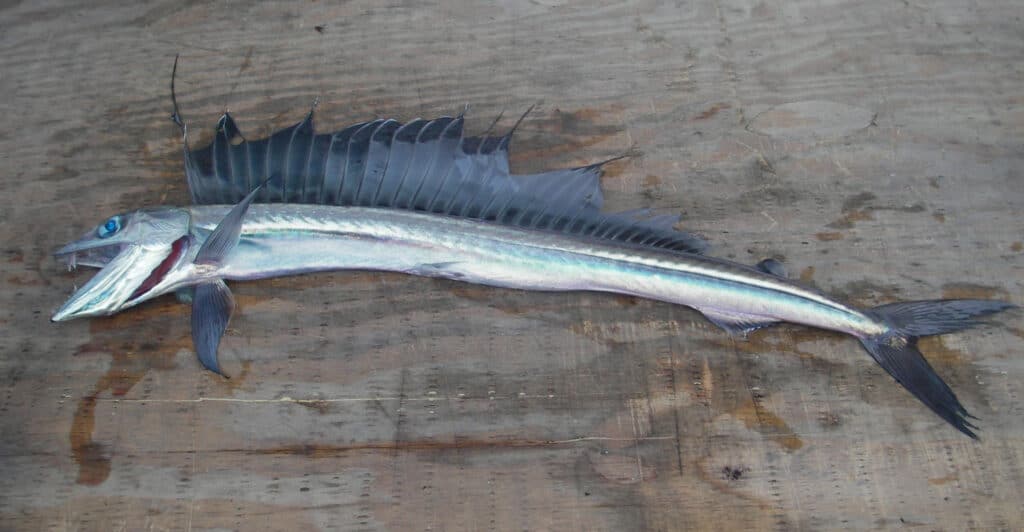Lancetfish
Alepisaurus ferox
Lancetfish live at depths up to 6,500 feet below sea level
Advertisement
Lancetfish Scientific Classification
- Kingdom
- Animalia
- Phylum
- Chordata
- Class
- Actinopterygii
- Order
- Aulopiformes
- Family
- Alepisauridae
- Genus
- Alepisaurus
- Scientific Name
- Alepisaurus ferox
Read our Complete Guide to Classification of Animals.
Lancetfish Conservation Status
Lancetfish Facts
- Prey
- Fish, octopus, squid, crustaceans
- Name Of Young
- Larva
- Group Behavior
- Solitary
- Fun Fact
- Lancetfish live at depths up to 6,500 feet below sea level
- Biggest Threat
- Marine predators
- Most Distinctive Feature
- Large dorsal fin and fangs
View all of the Lancetfish images!
Summary
Lancetfishes are among the largest deep-dwelling fish in the world. The two extant species both belong to the genus Alepisaurs in the family Alepisauridae, of which they are the sole members. They sport long, high dorsal fins that aid them in chasing after prey and sharp fangs designed for grabbing flesh. Little is known about their behavior, including how they breed. Despite its sweet taste, no commercial market exists for lancetfish meat due to its gelatinous texture.
5 Lancetfish Facts
- Lancetfish are bathypelagic fish capable of living at depths over 6,500 feet below sea level.
- The largest lancetfish can grow up to 7 feet long, ranking them among the largest deep-sea fish in the world.
- Lancetfish are hermaphrodites, meaning they simultaneously possess both male and female sex organs.
- Fisheries consider lancetfish pests because they often eat the bait set for more valuable fish like tuna.
- Due to their gelatinous muscles, lancetfish are likely ambush predators that rely on camouflage and quick bursts of speed to capture prey.
Lancetfish Scientific Name
There are two extant species of lancetfish; the long-snouted lancetfish (Alepisaurus ferox) and the short-snouted lancetfish (Alepisaurus brevirostris). Both species are in the genus Alepisaurus and the monogeneric family Alepisauridae. The genus derives from the Greek words a (without), lepis (scale), and sauros (lizard), which together translate as “scaleless lizard.” Meanwhile, the lancetfish gets its common name from its long, slender body, which resembles a silver lance.
Lancetfish Appearance

The largest lancetfish can grow up to 7 feet long, ranking them among the largest deep-sea fish in the world.
©2,046 × 1,062 pixels, file size: 1.22 MB, MIME type: image/jpeg – License
Lancetfishes feature a long, high dorsal fin with anywhere from 41 to 44 rays. The dorsal fin runs nearly the entire length of the back and measures nearly twice as high as the lancetfish is deep. Meanwhile, the caudal fin is noticeably forked, while the pectoral fins are long and located low on the sides of the body. Lancetfishes are extremely long and thin. The body measures widest at the gills and tapers slowly to a slender point near the caudal peduncle at the rear. In combination with their silvery-white color, this shape means they closely resemble a knight’s lance, hence their name.
The mouth of a lancetfish is relatively large and wide, given its slender frame. Two or three large fangs protrude from both jaws that contain numerous smaller teeth. Unlike most fish, lancetfishes lack scales, and their muscles are gelatinous and watery. The only noticeable difference between the two species rests in the shape of their snouts. As its name suggests, the long-snouted lancetfish (A. ferox) possesses a noticeably longer nose than its short-snouted cousin, A. brevirostris.
Lancetfishes are among the largest deep-sea fish in the world. Full-grown specimens can grow up to 7 feet long and weigh nearly 20 pounds. That said, the average lancetfish measures around 5 feet long and weighs between 3 and 7 pounds.
Lancetfish Behavior
Given their deep-dwelling habits, little is known about the behavior of lancetfish. Their large mouths and teeth indicate they live a predatory lifestyle. They likely rely on their large dorsal fin to help them stay on course when chasing prey. That said, their watery, gelatinous muscle means they aren’t suited for lengthy pursuits. Instead, they likely rely on stealth and ambush tactics to sneak up on their prey. Meanwhile, their large fangs help them to capture and hold on to prey before it can escape.
Lancetfishes are typically encountered at bathypelagic depths several thousand feet below sea level. However, they sometimes make their way closer to the surface. The reason for this behavior remains unknown, and no evidence suggests they make vertical migrations to search for food or mate. By all accounts, lancetfishes are primarily solitary, deep-dwelling fish that eat anything and everything they can catch.
Lancetfish Habitat
As mesopelagic and bathypelagic fish, lancetfishes range between 300 and 6,500 feet below sea level. However, they spend most of their time at depths of around 3,000 feet. The cold, dark water where they reside receives almost no light. In this cold, dark water, lancetfish hunt their prey relying on stealth and short bursts of speed. They prefer tropical and subtropical waters but occasionally migrate to more temperate regions to hunt.
Lancetfish Diet
Lancetfishes are carnivorous predators. They possess a voracious appetite and will readily eat almost anything that they can catch. Given their watery muscles, they lack the speed and power to chase after quick fish. As a result, they likely rely on ambush tactics to sneak up on their prey. With a quick burst of speed, they get close enough to where they can latch onto their target with their oversized jaws and fangs. Their diet is extremely varied and consists of a wide variety of fish, octopuses, squids, and crustaceans. Moreover, lancetfishes are willing cannibals and frequently feed on other members of their species. Despite their large appetite, they don’t immediately digest everything they eat. On the contrary, evidence suggests that they often consume a meal and then store it for digestion at a later time.
Lancetfish Predators and Threats
Lancetfish are frequently caught by fishers trawling for more valuable fish such as tuna. However, they aren’t commercially hunted due to the watery texture of their flesh. As a result, the primary threat to lancetfish comes not from humans but from other marine predators. Several animals prey on lancetfish, including tuna, sharks, and fur seals. They must also often contend with other lancetfish, as they are willing cannibals that won’t hesitate to eat their own kind.
Lancetfish Reproduction and Life Cycle
One of the least understood behaviors of lancetfish concerns their method of reproduction and life cycle. To date, no one has ever witnessed them reproducing. That said, researchers have managed to infer some information about their habits. Lancetfishes are hermaphrodites, meaning they simultaneously possess female and male sex organs. Given their small eggs and larva, they likely spawn groups of eggs that drift freely in pelagic waters. Currently, it’s unclear whether they breed seasonally, and their rate of maturation and life expectancy also remain unknown.
Lancetfish Population
Currently, insufficient data exists on lancetfish populations. They are frequently caught by fishers but aren’t targeted by fisheries due to the watery texture of their flesh. Additionally, they live far below sea level and rarely congregate in large numbers, so it’s difficult to estimate their total population. That said, you can find lancetfishes throughout much of the world, even in relatively colder waters that they typically shun. Given their widespread distribution and lack of commercial interests, it’s safe to assume lancetfish populations are relatively stable.
Lancetfish Locations:
You can find lancetfishes all over the world in mesopelagic and bathypelagic waters. They are widely distributed throughout the Pacific, Atlantic, and Indian Oceans. While they prefer topical and subtropical water, they occasionally venture into the colder waters of the Southern and Arctic Oceans.
Lancetfish Conservation Status:
Lancetfishes remain a mystery to researchers and conservationists alike. Commercial fisheries’ lack of interest in lancetfish has meant that they are rarely recovered and studied. Recovery efforts are further stymied because they primarily live far below sea level. At this time, lancetfishes are Not Evaluated by the IUCN, nor are they protected by any treaties such as CITES.
Similar Animals
View all 98 animals that start with LLancetfish FAQs (Frequently Asked Questions)
Are lancetfish carnivores, herbivores, or omnivores?
Lancetfishes are carnivorous predators that hunt a wide variety of prey. They are willing cannibals whose prey includes fish, octopus, squid, and crustaceans.
Can you eat lancetfish?
Unlike most fish, lancetfish flesh is quite watery and gelatinous. That said, while the texture is rather unpleasant, the taste is somewhat sweet.
How deep do lancetfish live?
Lancetfish are mesopelagic and bathypelagic fish. While occasionally found close to the surface, they prefer deeper water and can live at depths of 6,500 feet below sea level.
How large can lancetfish grow?
Lancetfish are among the largest deep-sea fish in the world. At their largest, they can grow up to 7 feet long and weigh nearly 20 pounds.
Thank you for reading! Have some feedback for us? Contact the AZ Animals editorial team.

















